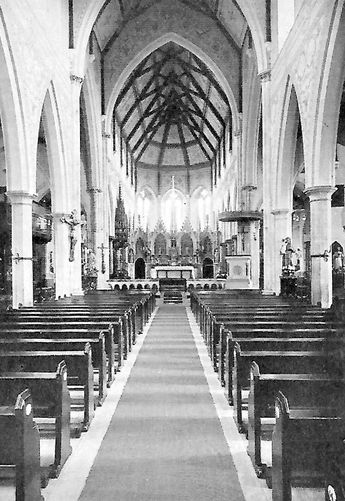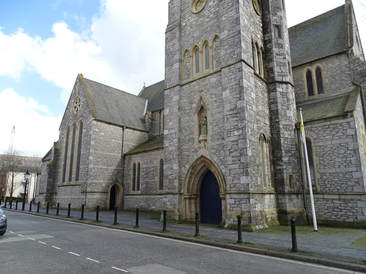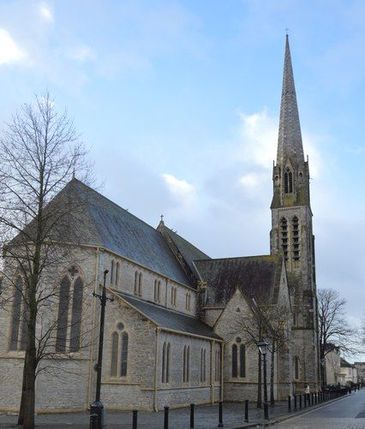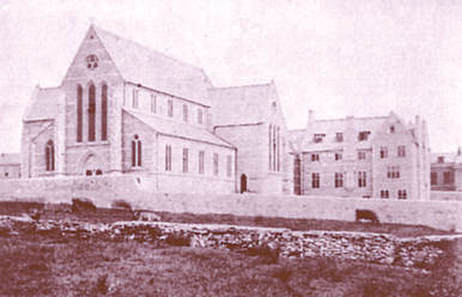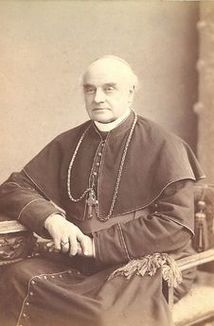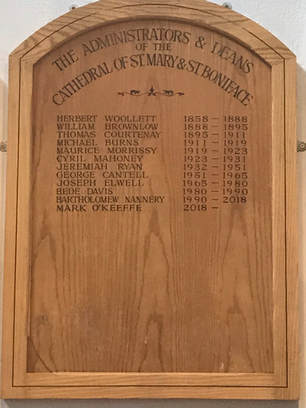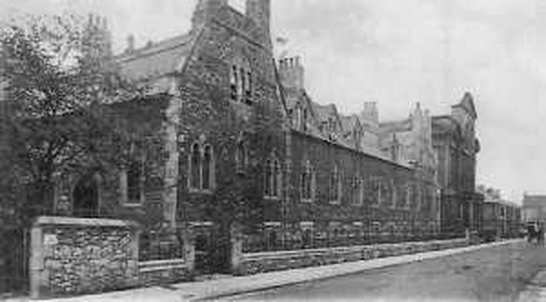The Story and Prayer of St Boniface
Devotion to the Sacred Heart
|
A Visit to the Blessed Sacrament Chapel of Plymouth CathedralJoin us to explore the beauty of the Blessed Sacrament Chapel in memory of Bishop William Vaughan, the second Bishop of Plymouth
The first internal photograph of the Cathedral c. 1885
|
|
Construction
Since the diocese's foundation, the small church of Saint Mary, erected in 1807 at Saint Mary Street, had served as Pro-cathedral. Vaughan decided to build a cathedral replacing the pro-cathedral. On 20th February 1856, he bought a portion of “Fivefields” on Eldad Hill at the then towns’ outskirts. Mr. Edmund Bastard promised £1000 and a successful appeal was launched to raise the rest of the money throughout the diocese and country. The Hansom Brothers, Joseph and Charles (of “Hansom Cab” fame) became the architects and Mr. Roberts of Stonehouse the builder. His tender came to £3904 and was accepted on 22nd May 1856. Work started 22nd June. There were construction problems including subsidence caused by an English Naval Officer firing new heavy Turkish Man-of-War guns in Plymouth Sound. The Bishop’s house was constructed and the clergy moved in on the 23rd September 1857. The Cathedral was opened at the Feast of the annunciation on 25th March 1858. The Te Deum was sung at the close of the ceremony. |
Founding
Plymouth’s first Roman Catholic bishop was George Errington, a Yorkshire man, who had been Vice-rector to the English College in Rome. As priest at St. John’s Church in Salford, Manchester he was consecrated Bishop by Cardinal Wiseman on the 25th July 1851. In Plymouth, Bishop Errington soon overcame the bigotry of the town towards Catholics and concentrated on building up a Chapter of Canons and the Deaneries of the Diocese. He provided support for his few priests and supported his missions. Particularly active in the Stonehouse Mission, he celebrated the Sacraments and visited the sick and dying. He became especially fond of his weekly visit to Dartmoor Prison. Four years later Errington was appointed coadjutor Archbishop of Westminster, and on 19 July 1855, William Vaughan from Bristol was consecrated the new Bishop of Plymouth. Canon William Vaughan’s family provided many bishops for England. At the Restoration of the Hierarchy he was responsible for the Pro-Cathedral of the Holy Apostles in Clifton, Bristol. It was there that Cardinal Wiseman consecrated him on 19th July 1855. At that time there were only twenty-three missions and twenty-three priests in Plymouth Diocese. After his forty-seven years as a bishop, there were one hundred priests, thirteen male religious houses, twenty-eight nuns’ houses, four orphanages, twenty-seven elementary schools and five schools for older children. Truly, Bishop Vaughan was a Founding Father of the Plymouth Diocese Photo above: Plymouth Cathedral 1889 Photo left: One of he first external photographs of the ongoing construction of the Cathedral |
|
Bishop Vaughan
Bishop Vaughan built a church for the Catholics in Devonport and the sailors who were regularly in port. To do this he applied to the Secretary of State for War, Lord Panmure, for a site. The strength of numbers of the faithful averaging at least eight hundred swung the argument and “Prince’s Gardens” at Mutton Cove was offered. Schools were built on the south side of the site and the Chapel Street School moved in. By 24th September 1859 the Bishop was able to build the nave and aisle for a church. This became the Church of St. Michael and St. Joseph and its foundation stone was laid on 25th June 1860. The building work, done by Mr. Roberts the builder of the Cathedral, was completed. The opening celebration led by Bishop Vaughan took place on 19th December 1861. This was the military chaplaincy for the army and navy. The Devonport Mission became a thriving servant to the civilians and military people of Devonport. |
|
Cathedral Administrators
The first Administrator of the Cathedral was Canon Herbert Woollet. Canon Woollett arrived in Plymouth with Bishop Vaughan in 1855, to be the Bishop's Secretary. He moved into the still to be completed Bishop's House that same year and then became administrator of the Cathedral, a task he performed for thirty years until his death in 1888 at the age of 71. Canon Woollett was a man of many roles: naval chaplain to HMS Hotspur, Chairman of the Governors of the Cathedral School; he founded the Secular Clergy Fund in 1861 to financially support priests who had retired and he was made Doctor of Divinity in 1872. His hectic life likely lead to his serious heart condition, which he suffered from in the final years of his life. He died in May 1888 at Bishop's House after a serious of heart attacks. He is buried in the Catholic section of Ford Park Cemetery where a granite tombstone marks his resting place. |
Canon Woollett still has the distinction not only of being the first administrator of the Cathedral, but also the longest administrator; he served for thirty years and to this day no other administrator has served as long.
The role of Dean of the Cathedral was created in 2001. Our first Cathedral Dean was Monsignor Canon Bartholomew Nannery, who served for twenty eight years and retired in 2018.
The role of Dean of the Cathedral was created in 2001. Our first Cathedral Dean was Monsignor Canon Bartholomew Nannery, who served for twenty eight years and retired in 2018.
|
|
|
|
Convent School
On 26 July 1860 the Sisters of Notre Dame de Namur, who looked after poor schools, settled in the presbytery of St Mary's Church. On 19 October 1858, they purchased land near the Cathedral and opened a convent and girls' boarding and day school. It was closed after being bombed during the Plymouth Blitz of 1941. It has now been redeveloped as a residential complex. The Notre Dame Catholic School is now located in the Plymouth suburb of Derriford.
The original town of Sutton Pool had been where a convent of Poor Clares had, until 1834, lived. Carmelite nuns from Lanherne convent brought and settled in Gasking House where the pre-Reformation Friary had stood. In its garden, mission buildings were built and schools opened. By 1872, the work was completed but the Carmelites did not stay long, soon moving to Wells in 1875. Sisters of Charity of St. Vincent de Paul took over the buildings as an orphanage. The Sisters continued their work there until 1920, when they moved to Saltash in Cornwall. Holy Cross Church in Ebrington Street also served the East Plymouth Mission.
Bishop Vaughan invited the Notre Dame Sisters to look after poor schools that had been set up in Plymouth. On 26th July 1860 they settled in the presbytery of St. Mary’s and from there taught at the Cathedral and Devonport missions. Soon, they purchased land immediately to the west of the Cathedral and, on 19th October 1858, they opened a convent and girls’ boarding and day school. It operated successfully until it was bombed during the Second World War. Today the site has been redeveloped and is a residential complex called Notre Dame House.
On 26 July 1860 the Sisters of Notre Dame de Namur, who looked after poor schools, settled in the presbytery of St Mary's Church. On 19 October 1858, they purchased land near the Cathedral and opened a convent and girls' boarding and day school. It was closed after being bombed during the Plymouth Blitz of 1941. It has now been redeveloped as a residential complex. The Notre Dame Catholic School is now located in the Plymouth suburb of Derriford.
The original town of Sutton Pool had been where a convent of Poor Clares had, until 1834, lived. Carmelite nuns from Lanherne convent brought and settled in Gasking House where the pre-Reformation Friary had stood. In its garden, mission buildings were built and schools opened. By 1872, the work was completed but the Carmelites did not stay long, soon moving to Wells in 1875. Sisters of Charity of St. Vincent de Paul took over the buildings as an orphanage. The Sisters continued their work there until 1920, when they moved to Saltash in Cornwall. Holy Cross Church in Ebrington Street also served the East Plymouth Mission.
Bishop Vaughan invited the Notre Dame Sisters to look after poor schools that had been set up in Plymouth. On 26th July 1860 they settled in the presbytery of St. Mary’s and from there taught at the Cathedral and Devonport missions. Soon, they purchased land immediately to the west of the Cathedral and, on 19th October 1858, they opened a convent and girls’ boarding and day school. It operated successfully until it was bombed during the Second World War. Today the site has been redeveloped and is a residential complex called Notre Dame House.
The First Mass
The opening ceremony on the Feast of the Annunciation 1858 was placed under the direction of the Rev John Bonomi of Llansanfreed and Canon Talbot. The Bishop, having vested for Mass in the Sacristy at 11 o'clock, the procession proceeded thence down the South aisle and up the centre of the Nave to the Sanctuary.
"The Crossbearer was Rev T. L. Coghlan, the clergy vested in cottas were Revs James Carey, James Dawson, Luke Kelly, WIlliam Laffan and the Jesuit Fathers James Eccles and Charles Lomax. These were followed by Canons Platt, Woollett, Agar and Shortland in vestments, who subsequently took their places in the Canons' Stalls in the Sanctuary.
"Then came Rev E. Windeyer as Subdeacon of the Mass, Rev Joseph Benn Deacon of the Mass with the V. Rev Provost Brindle as Assistant Priest. Finally came the Bishop of Plymouth, accompanied by Canons Maurice Power and Richard Mansfield, his Deacon of the Throne.
"His Lordship preached the sermon after the Gospel; and in it congratulated all present at the completion of an edifice hardly considered possible but three years previous, finished, too, under so many disappointments. He expressed his thankfulness that not a life had been lost or limb injured of any one engaged on the operations throughout this chequered progress.
"The music was Weber's in G conducted by Organist, M. Leopold de Prins. At the end of the Mass the Te Deum was sung.
(Archives 2016 (407))
"The Crossbearer was Rev T. L. Coghlan, the clergy vested in cottas were Revs James Carey, James Dawson, Luke Kelly, WIlliam Laffan and the Jesuit Fathers James Eccles and Charles Lomax. These were followed by Canons Platt, Woollett, Agar and Shortland in vestments, who subsequently took their places in the Canons' Stalls in the Sanctuary.
"Then came Rev E. Windeyer as Subdeacon of the Mass, Rev Joseph Benn Deacon of the Mass with the V. Rev Provost Brindle as Assistant Priest. Finally came the Bishop of Plymouth, accompanied by Canons Maurice Power and Richard Mansfield, his Deacon of the Throne.
"His Lordship preached the sermon after the Gospel; and in it congratulated all present at the completion of an edifice hardly considered possible but three years previous, finished, too, under so many disappointments. He expressed his thankfulness that not a life had been lost or limb injured of any one engaged on the operations throughout this chequered progress.
"The music was Weber's in G conducted by Organist, M. Leopold de Prins. At the end of the Mass the Te Deum was sung.
(Archives 2016 (407))
The Cathedral today
Quick Links
